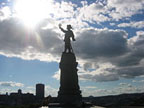
With the 400th anniversary of the founding of Quebec City being celebrated this
year in Quebec and elsewhere across country, Samuel de Champlain is the subject
of many tributes and discussions. This major anniversary affords us an
opportunity to reflect on the meaning and value of history.
A royal geographer to Henry IV of France, Champlain was a talented navigator and
cartographer. Among his achievements, he charted the coast of the St. Lawrence
River, Lake Champlain, the Ottawa River and many other areas.
The main mapping technology
of his day was the astrolabe. The ultimate GPS system, the astrolabe enabled the
user to establish latitude based on the position of the sun and other celestial
bodies.
The founder of New France was guided across the ocean by his dream for a better
world. Looking up at the heavens, he could see the stars and the sun, which he
used as “celestial landmarks” on his way to the New World.
Using his astrolabe, he
found his way to an “undiscovered” land and was able to draw up maps for others
to use as they set out to make history in the New World.
The value of the astrolabe as a practical mapping tool is undeniable: astrolabes
have been used in many cultures throughout the history of humanity, including in
Ancient Greece, Islamic and Arabic cultures, Europe and India.
But the astrolabe is also a powerful symbol. When we are aware of our dreams and aspirations in life, we are looking at the stars. We can then centre ourselves and, using our inner GPS, concentrate on making our dreams and aspirations a reality.
With these stars as our
guides, we can set out to explore uncharted lands, mapping out our own future
and showing the way to a New World.